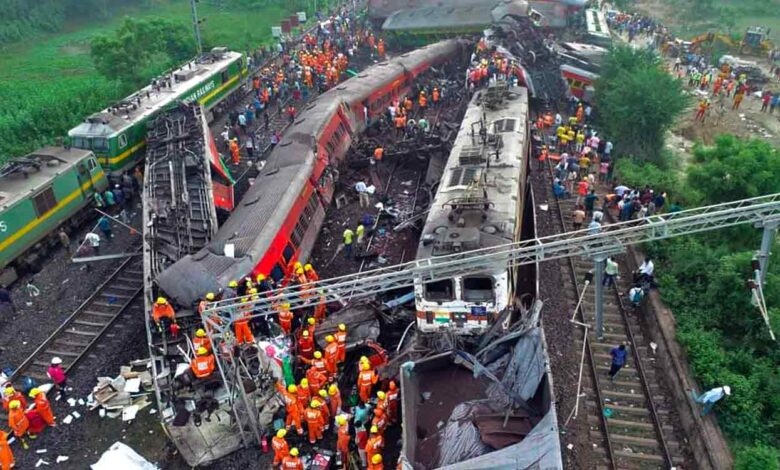The CBI should investigate the identified accident cause Minister of Transport Vaishnaw

The Railway Board has requested a Central Bureau of Investigation (CBI) investigation into the train accident in Odisha’s Balasore that killed 275 people and injured nearly 1,100, Union Railways Minister Ashwini Vaishnaw said on Sunday evening. Vaishnaw also suggested that authorities were investigating a possible sabotage attempt, even as officials on the ground bulldozed capsized coaches, relaid tracks, and installed new overhead lines in an effort to restore operations on the impacted
Earlier in the day, Vaishnaw stated that a change in the interlocking and point machine, an intricate system of interconnected safety checks designed to prevent trains from colliding, was the cause of India’s fourth-worst railway accident.
In the meantime, healthcare workers in the region faced a monumental challenge, with hundreds of injured occupying hospital beds and families poring over lists and photographs to identify dead corpses, many of which were irreparably disfigured.
“We have recommended a CBI investigation into the triple-train accident,” Vaishnaw said in Odisha’s capital Bhubaneswar on Sunday evening, amidst resistance from opposition groups, many of whom demanded his resignation as minister.
Friday at 6:56 p.m., the Chennai-bound Coromandel Express collided with a cargo train carrying iron ore at the Bahanaga Bazar station in Balasore, hurling several compartments onto the adjacent track. A few of these carriages collided with the last two cars of the Yesvantpur Express that was travelling in the opposite direction towards Howrah. On Saturday evening, the death toll was estimated to be 294, but senior Odisha officials clarified on Sunday that the figure had been revised to 275 due to repetitions.
Earlier on Sunday, Vaishnaw stated in Balasore that a modification to a point machine was the origin of the calamity.
How and why it was done will be disclosed in the investigation report…The underlying cause of the horrific event has been identified… I do not want to go into details. Vaishnaw said, “Let the report (by the commissioner of railway safety) be released.”
A point is essentially a piece of track that can be moved to alter the direction of a train. They are moved using switches operated from a control panel and are an integral element of the Indian Railway’s 120,000 km-long network. As was the case on Friday evening, points along a line are “interlocked” and operate in tandem with signals to ensure trains on the same track do not collide and a train does not enter an already occupied line.
During a press briefing in Delhi on Sunday afternoon, Railway Board member Jaya Verma Sinha described the interlocking system as “error-proof” and “fail-safe.”
“Even if it fails, all the signals will turn red and train operations will cease… It is possible that someone has dug without noticing the cables. “The operation of any machine is prone to failure,” she stated.
Verma stated that preliminary investigations revealed that the high-speed Coromandel Express was given a signal to run on the main track line, but that signal was subsequently altered, causing the passenger train to enter the adjacent loop line, where it collided with the parked goods train.
At the time of publication, Indian Railways crews had restored two of the four lines on the track (the XX and XX), while work continued to restore the overhead electric lines that power the trains. The XX and XX lines were still in the process of being relaid.
Nearly one hundred trains traversing the busiest line have been affected, according to officials.
Atul Karwal, the director general of the National Disaster Relief Force (NDRF), stated that the rescue operation was nearly complete. “I do not believe there is any other way to locate additional survivors or corpses. I believe operations will recommence at this time,” he said in Balasore.
Karwal stated that nine squads and approximately 300 rescue workers continue to search the site.
PK Jena, the chief secretary of Odisha, stated that 88 of the 275 bodies had been identified, and 78 had been returned to their families. According to him, 187 are still unidentified.
“DNA samples will be collected, and photos of the deceased will be uploaded to government websites,” he said.
Opposition parties continued to target the central government led by the Bharatiya Janata Party (BJP) over the tragedy, demanding accountability and Vaishnaw’s resignation as rail minister.
Mamata Banerjee, chief minister of West Bengal and president of the Trinamool Congress (TMC), questioned the death toll while the Congress questioned whether Prime Minister Narendra Modi would take responsibility for the “deadliest rail tragedy” of the century.
On Sunday, the leader of the Congress, Rahul Gandhi, demanded that Vaishnaw hand in his resignation letter and stated that “no accountability even after 270+ deaths” existed.
In response, the BJP urged opposition parties not to politicise the Balasore train accident and stated that the record of the railway ministers in the Congress-led UPA government was “nothing short of a disaster.”
BJP IT department head Amit Malviya shared on Twitter what he claimed were the details of accidents under Banerjee and Bihar chief minister Nitish Kumar, when they were railway ministers, and added that such “worthies” are demanding the resignation of the “most qualified” railway minister the country has had in the past seven and a half decades.
Certainly, Nitish Kumar resigned as railway minister following the 1999 Gaisal train accident, in which 290 people were murdered. Banerjee resigned in 2000 following a railway accident in Punjab, but Prime Minister Atal Bihari Vajpayee subsequently asked her to remain in her position.



